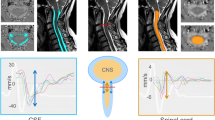Summary
Forty-seven patients with posterior fossa tumours underwent continuous monitoring of intracranial pressure (ICP) in the early postoperative period by means of an intraventricular catheter.
ICP values were very low on the day of operation and subsequently became normal in 37 patients. ICP values were raised in 10 patients. The relationship between the ICP and the clinical course was investigated. Patients were subdivided according to the clinical postoperative course into three groups: good, temporarily deteriorated, poor clinical course. The two first groups showed lower values in the ICP than the third one, nevertheless the relationship between the ICP and the posteroprative clinical course is marked but not strict.
Our data may have some clinical relevance for the treatment of hydrocephalus before extirpation of posterior fossa tumours.
Similar content being viewed by others
References
Albright, L., Reigel, D. H., Management of hydrocephalus secondary to posterior fossa tumors. J. Neurosurg.46 (1977), 52–55.
Belapavlovic, M., Buchthal, A., Beks, J. W. F., Journee, H. L., Some principles of postoperative epidural pressure monitoring. Acta neurochir. (Wien)55 (1981), 227–245.
Hase, U., Reulen, H. J., Meining, G., Shulmann, K., The influence of decompres sive operation on the intracranial pressure and the pressurevolume relation in patients with severe head injuries. Acta neurochir. (Wien)45 (1978), 1–15.
Hase, H., Reulen, H. J., Shubert, R., Shulmann, K., The course of intracranial pressure and volume-pressure relationships following extirpation of meningiomas and astrocytomas. Acta neurochir. (Wien)44 (1978), 161–171.
Lundberg, N., Continuous recording and control of ventricular fluid pressure in neurosurgical practice. Acta Psychiatr. Scand. (Suppl.) (1961), 9–185.
Kaye, A. H., Brownbill, D., Post-operative intracranial pressure in patients operated on for cerebral aneurysms following subarachnoid hemorrhage. J. Neurosurg.54 (1981), 726–732.
Nornes, H., Magnaes, H., Supratentorial epidural pressure recorded during posterior fossa surgery. J. Neurosurg.35 (1971), 341–349.
Paltsev, E. I., Sirovsky, E. B., Intrabrain pressure, cerebrospinal fluid pressure and the P-V function of craniospina elasticity in patients after the extraction of tumors from the basal region and posterior fossa. In: Intracranial Pressure IV (Shulmann, K., Marmarou, A., Millwer, J. D., Becker, D. P., Hochwald, G. M., Brock, M., eds.), pp. 111–115. Berlin-Heidelberg-New York: Springer. 1980.
Paltsev, E. I., Sirovski, E. B., Intracranial physiology and biomechanics clinical data on pressurevolume relationships and their interpretation. J. Neurosurg.57 (1982), 500–510.
Pollay, M., Review of spinal fluid physiology, production and absorption in relation to pressure. Clin. Neurosurg.24 (1977), 254–269.
Ponten, U., Some observations on postoperative ventricular fluid pressure. Acta Neurol. Scand.39 (1963), 264–265.
Author information
Authors and Affiliations
Rights and permissions
About this article
Cite this article
Pappadà, G., Formaggio, G., Regalia, F. et al. Course of intracranial pressure after extirpation of posterior fossa tumours. Acta neurochir 70, 11–19 (1984). https://doi.org/10.1007/BF01406038
Issue Date:
DOI: https://doi.org/10.1007/BF01406038




